
Mushrooms are called sponge fungi that have tubes as a spore-forming fruit layer. This makes that part appear spongy. Mushrooms with a sponge belong to different families and sometimes have significant differences. Introducing 25 sponge mushrooms.
In a nutshell
- Sponge fungi also known as boletes or tube fungi
- Sponge mostly whitish to yellow
- in some species the sponge turns blue when pressed
- only a few spongi are poisonous
- most edible sponge mushrooms are better tolerated when heated
Table of contents
- Sponge mushrooms from A to E
- with F
- From G to M
- From N to R
- From S to Z
- frequently asked Questions
Sponge mushrooms from A to E
Apple fire sponge (Phellinus pomaceus)
The apple fire sponge is a Harmful fungus on fruit trees. It makes the wood brittle, which means that branches can easily break off.

- Cap: hoof-shaped, grey-black, occasionally fissured
- Stem: no stalk, firmly attached to the tree
- Sponge color: grey-brown, red-brown
- Location: exclusively on apple trees
- Edibility: inedible
- Risk of confusion: other fire sponge species, tinder fungus (Fomes fomentarius)
Birch fungus (Leccinum scabrum)
The birch mushroom is a popular edible mushroom, who in the company of birches can be found. In order for the sponge fungus to develop, the vegetation must be rather low.
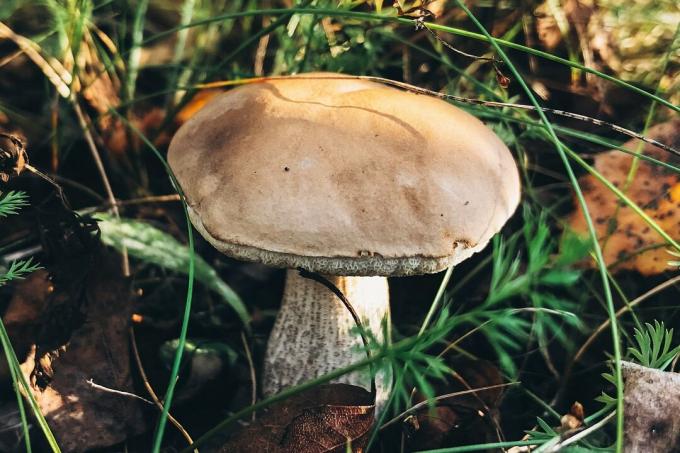
- Cap: grey-brown to red-brown, greasy when moist, unevenly convex
- Stem: dirty white, black-brown scales
- Sponge color: whitish, more gray in older mushrooms
- Location: around birch trees
- Edibility: edible
- risk of confusion: other birch mushroom species, hornbeam boletus (Leccinum griseum)
Blue-spotted purple boletus (Imperator rhodopurpureus)
The poisonous purple boletus can be recognized by its unpleasant odor, which is reminiscent of carrion. The bluish discoloration when cut is also striking.

You can contact this user here.
English | espanol | french | italiano | macedonian | മലയാളം | portuguese | +/−, 2008-08-04 Boletus rhodopurpureus 1 18733, Edited from Plantopedia, CC BY-SA 3.0
- Cap: crimson to dusky pink, velvety, scaly
- Stem: yellow, reddish net
- Sponge colour: yellow when young, later reddish
- Habitat: deciduous forests, on calcareous soils
- Edibility: toxic
- Risk of confusion: other boletus species
Butter fungus (Suillus luteus)
The butter mushroom belongs to the boletus family, which are edible. However, sensitive people can react with allergies or gastrointestinal complaints when consuming it, with the result that all species in the family should be avoided.
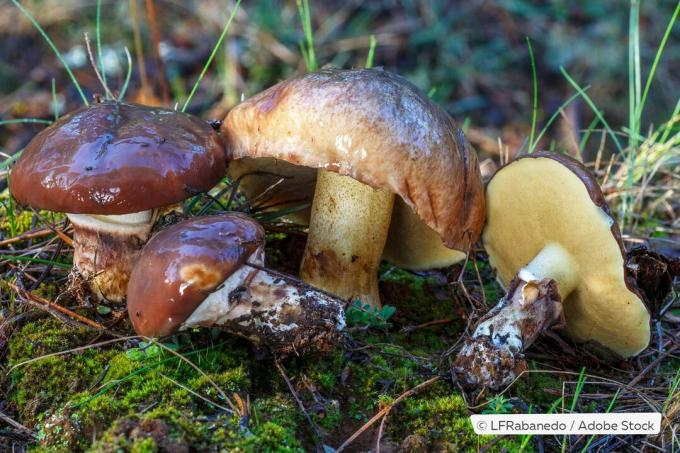
- Cap: brown, shiny, slimy to greasy
- Stem: yellow, brown-purple ring, brownish spots
- Sponge color: lemon yellow
- Location: symbiosis with Pine trees
- Edibility: edible
- Risk of confusion: other boletus species, other smear species
Redcap (Leccinum aurantiacum)
The deciduous forest red cap is considered a very good edible mushroom. The tube fungus is rare, however, since it is the symbiosis of oak trees needs.

- Hat: reddish brown, felty
- Stem: white ground color, reddish-brown scales
- Sponge color: whitish to yellow-brown
- Habitat: Mixed forests, mainly in the company of oaks, rarely with other deciduous trees
- Edibility: edible
- Risk of confusion: other Red Cap species
with F
False Satan Bolete (Rubroboletus legaliae)
There are various statements about the edibility of the boletus. Since it has to be cooked for at least a very long time, it is generally classified as inedible.

- Cap: light gray to reddish brown, occasionally reddish
- Stem: yellowish, reddish net
- Sponge color: purple
- Location: deciduous forests, with oaks or Book
- Edibility: toxic
- Risk of confusion: different species of purple boletus, Satan's boletus (Boletus satanas)
Norway spruce cap (Leccinum piceinum)
The spruce red cap is one of the most common species among the red caps. However, the sponge mushroom should not be eaten raw, but always fully cooked.
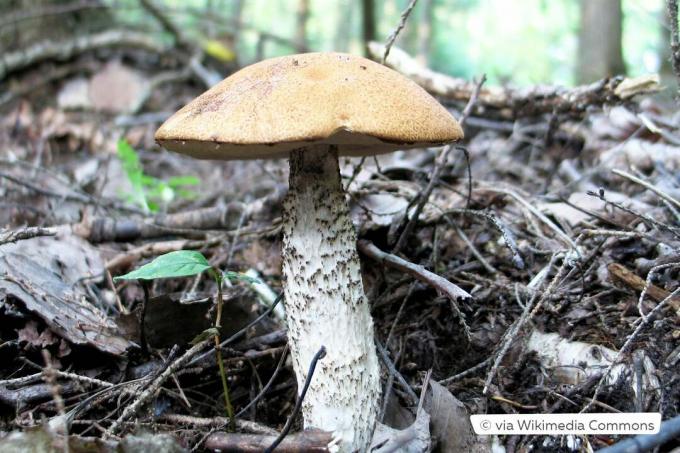
- Hat: reddish brown
- Stem: white ground color, black scales
- Sponge color: white-grey to grey-brown
- Location: at spruces, symbiosis with blueberries
- Edibility: edible
- Risk of confusion: other red cap species, spotted birch mushroom (Leccinum variicolor)
Felty boletus (Xerocomus submentosus)
The brown felt boletus will too goat lip called and is a widespread sponge fungus. The formation of the fruiting bodies begins in summer and continues into autumn.
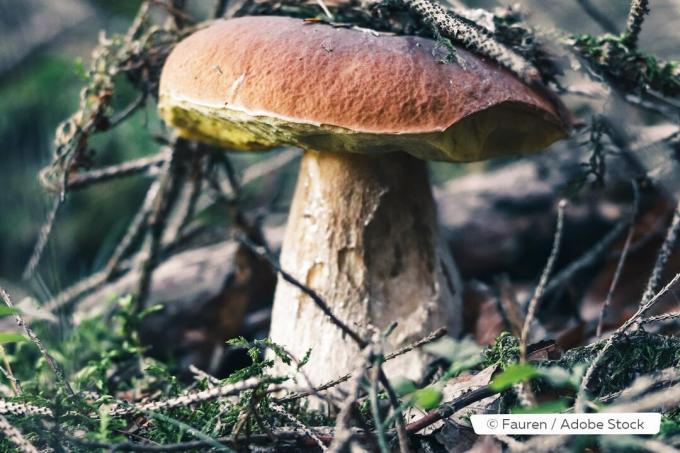
- Hat: grey-brown, tomentose
- Stem: yellowish, brownish net
- Sponge colour: yellow, bluing when pressed
- Location: mixed forest, mainly in the company of spruces
- Edibility: edible
- Likelihood of confusion: other boletus species, sand boletus (Suillus variegatus)
Flat Varnish Porling (Ganoderma applanatum)
The Lackporling is an inconspicuous fungus that grows on dead wood. He is considered a healing medicinal mushroom.
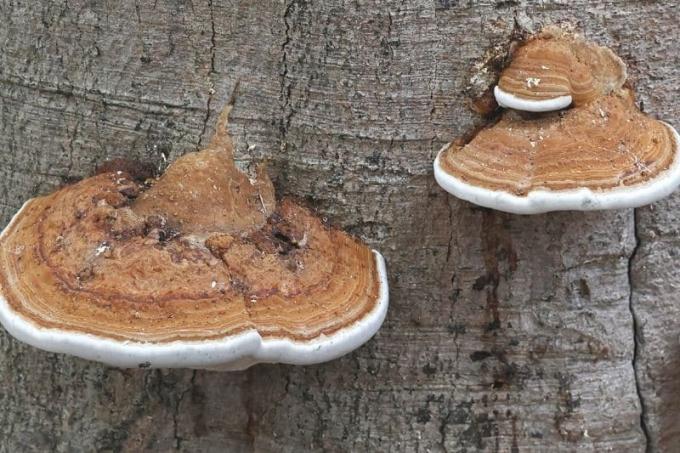
- Cap: brown to grey-brown, kidney-shaped
- Stem: without a stem, grown directly into the wood
- Sponge color: whitish, later yellowish
- Location: Deadwood from deciduous trees
- Edibility: inedible
- Danger of confusion: Tinder fungus (Fomes fomentarius), other Lackporling types
Flake-stemmed witch bolete (Neoboletus luridiformis)
The Flakestemmed Witch Bolete is one of the first edible mushrooms of the year. It can be found in the woods from May.

- Cap: dark brown, occasionally flecked with yellow, velvety, sticky
- Stem: yellow base, red flakes
- Sponge color: red, young mushrooms with yellowish tubes
- Habitat: Mixed forest, prefers acidic soil
- Edibility: edible
- risk of confusion: other species of witch boletus, other species of purple boletus
From G to M
Common gall boletus (Tylopilus felleus)
The common bile boletus is usually easy to recognize by its taste, because it tastes unpleasantly bitter. Hence the name "Bitterling". Even a single mushroom in a dish can spoil the whole dish.

- Hat: light brown, sometimes dark brown
- Stem: light brown, brown net
- Sponge color: white to pink
- Location: Mixed forests with spruce
- Edibility: inedible to poisonous
- Risk of confusion: other boletus species, chestnut boletus (Imleria badia), porcini mushroom (Boletus edulis)
Smooth-stemmed witch bolete (Suillellus queletii)
The smooth-stemmed boletus has little food value. However, it is suitable for mixed dishes with other mushrooms.
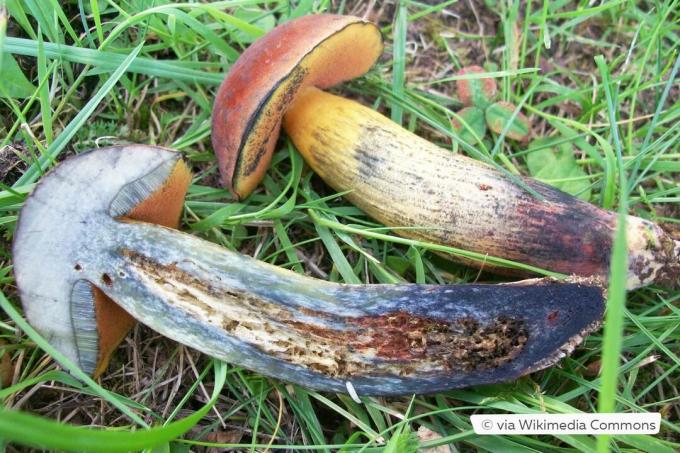
- Cap: variable colouring, from brown to reddish
- Stem: yellow
- Sponge color: yellowish to orange
- Location: Deciduous forests, preferably with oaks or beeches
- Edibility: edible
- Risk of confusion: other boletus species
A notice: Identifying the smooth-stemmed witch bolete is not easy. If you are not sure, you should avoid the sponge mushroom, especially since its taste is not very intense either.
Red-footed boletus (Xerocomellus pruinatus)
The autumn red foot has a mild taste of its own. It can be infested with mold and must then no longer be consumed.
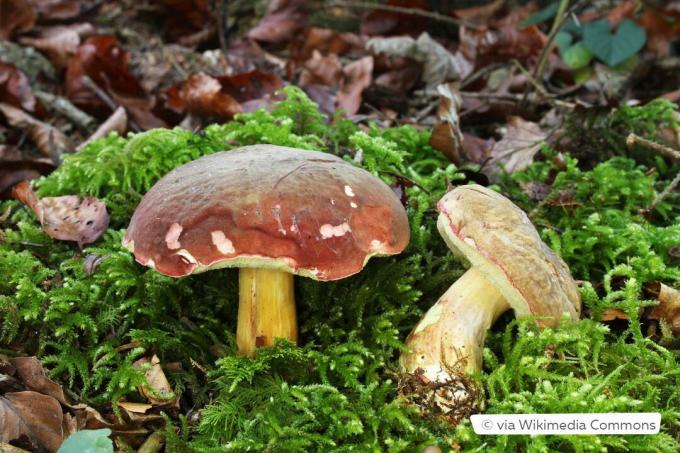
- Cap: gray with reddish edge, sticky when wet
- Stem: reddish, flaky
- Sponge color: yellow to brownish
- Location: mixed forests
- Edibility: edible
- Risk of confusion: other boletus species, especially red-legged boletus species
Cow boletus (Suillus bovinus)
The boletus is a good mixed mushroom. When cooked, the flesh turns pink to purple.

- Cap: light brown to brown, greasy, shiny, hemispherical to cushion-shaped, edges wavy curved
- Stem: light brown, base often pink to red
- Sponge colour: greyish yellow, later brownish to reddish brown
- Location: in the company of pines
- Edibility: edible
- Risk of confusion: other boletus species, goat's lip (Xerocomus subtomentosus), sand boletus (Suillus variegatus)
Chestnut bolete (Imleria badia)
The chestnut boletus is a popular edible mushroom that can be found in autumn. It has a pleasant nutty-mushroom taste.

- Cap: light brown to dark brown, tomentose, shiny when wet
- Stem: brownish to yellow-brown
- Sponge color: yellowish to greenish, bluing when pressed
- Location: mixed forests, coniferous forests
- Edibility: edible
- risk of confusion: other boletus species, porcini (Boletus edulis)
From N to R
Coniferous sulfur polypore (Laetiporus montanus)
The coniferous sulfur polypore is an excellent edible mushroom when young, but it is rarely collected. However, it may only be used from wood that is not poisonous, because it can absorb toxins from wood.
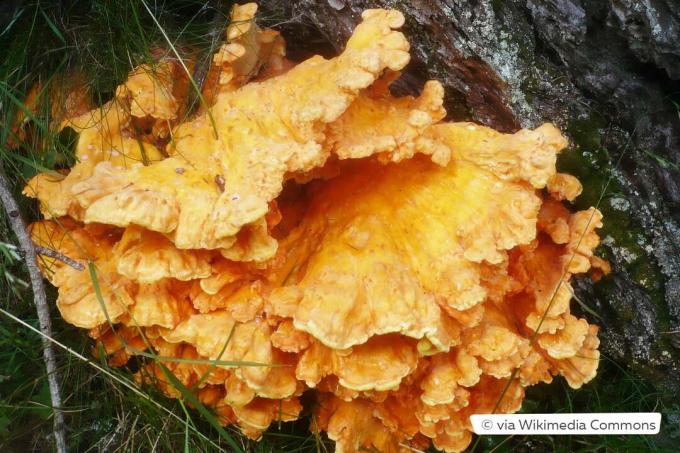
- Cap: yellow to orange
- Stem: without stem, fused with the wood
- Sponge color: yellow
- Habitat: on deciduous trees, rarely on conifers
- Edibility: edible
- Risk of confusion: other Porling species
Net-stalked bolete (Suillellus luridus)
The netted boletus is only conditionally edible. There are always people who can easily eat the overcooked sponge mushroom, but sensitive people can sometimes experience severe gastrointestinal problems.

You can contact this user here.
English | espanol | french | italiano | macedonian | മലയാളം | portuguese | +/− derivative works: Ak cc, 2010-09-13 Boletus luridus Schaeff 104527 crop, Edited from Plantopedia, CC BY-SA 3.0
- Cap: light brown to dark brown, occasionally grey-brown, velvety, sticky, surface bluing under pressure
- Stem: red-brown to yellowish ground colour, brown net
- Sponge color: yellow, later orange-yellow to reddish
- Habitat: deciduous forests, parks, prefers calcareous soils
- Edibility: conditionally edible
- Likelihood of confusion: other witch boletus species, other purple boletus species
Ringless Butter Mushroom (Suillus collinitus)
The Ringless Butter Mushroom has a fruity smell. Its food value is average. It is therefore mainly suitable for mixed dishes with other mushrooms.

- Cap: brown, shiny, moist, greasy
- Stem: yellowish, without a ring, brownish fine points
- Sponge color: yellow
- Habitat: Forest edges, parks, likes to be in the company of spruces
- Edibility: edible
- Risk of confusion: different boletus species, granulated boletus (Suillus granulatus), butter fungus (Suillus luteus)
Red-footed boletus (Xerocomellus chrysenteron)
The red-footed boletus has a mushroomy and slightly sour taste of its own. It can be infested with mold and must then no longer be consumed.
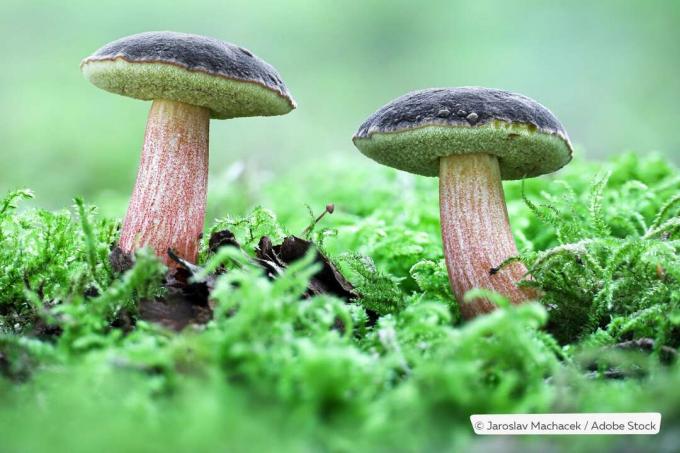
- Cap: brownish, tomentose, older mushrooms torn with red coloring between the fissures
- Stem: reddish, dotted, without markings
- Sponge color: yellow to olive yellow
- Location: mixed forests
- Edibility: edible
- Risk of confusion: other boletus species, chestnut boletus (Imleria badia), red-footed boletus (Xerocomellus pruinatus), goat's lip (Xerocomus subtomentosus)
From S to Z
Sand Boletus (Suillus variegatus)
The sand boletus has a pleasant mushroomy taste with a slightly sour note. Among the boletus, it is one of the best edible mushrooms.
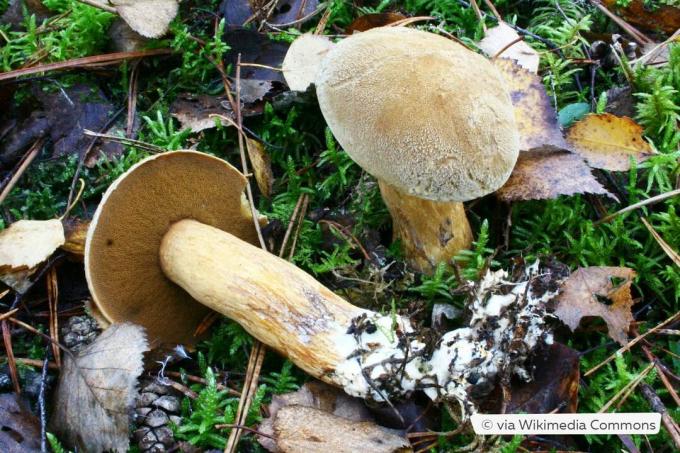
- Cap: yellow to ocher, tomentose, dull, scaly
- Stem: yellowish ground colour, frosted with brown granules
- Sponge color: yellowish to brownish
- Location: in the company of pines
- Edibility: edible
- Risk of confusion: different boletus species
Boletus (Butyriboletus fechtneri)
The silver boletus would be an excellent edible mushroom because it tastes like marzipan. Unfortunately, it is now rarely found, which is why it is already fully protected in many regions and may not be collected.
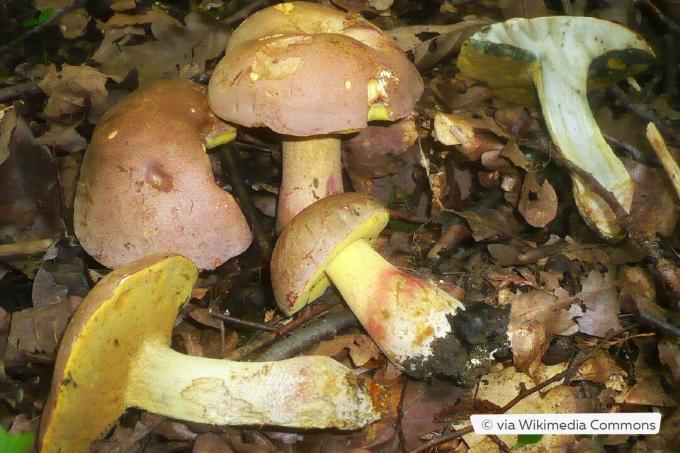
You can contact this user here.
English | espanol | french | italiano | macedonian | മലയാളം | portuguese | +/− derivative works: Ak cc, 2012-08-26 Boletus fechtneri Velenovsky 254739 crop, Edited from Plantopedia, CC BY-SA 3.0
- Cap: silver-grey to reddish brown, silky, hemispherical, cushion-shaped
- Stem: yellowish, white or pink net
- Sponge colour: yellow, bluing when pressed
- Location: deciduous forests, alluvial forests, in the company of beeches or oaks
- Edibility: edible
- Risk of confusion: different boletus species, porcini mushroom (Boletus edulis), chestnut boletus (Imleria badia)
Porcini mushroom (Boletus edulis)
The mean mushroom is probably the best known and most popular sponge fungus. It is versatile in the kitchen and can be dried very well.

- Hat: hazel, leathery
- Stem: whitish to brownish, with age with web
- Sponge color: whitish to yellowish
- Location: Mixed forests with conifers
- Edibility: edible
- Risk of confusion: other boletus species, other boletus species
Redfoot (Xerocomus ripariellus)
The rare redfoot can be attacked by mold and is then no longer edible. Don't eat old specimens either.

- Cap: brownish to reddish, torn open, felty, velvety
- Stem: reddish dotted
- Sponge color: yellow
- Habitat: Mixed forests, alluvial forests, especially in the area of banks
- Edibility: edible
- Risk of confusion: other boletus species, chestnut boletus (Imleria badia)
Woolly boletus (Leccinum cyaneobasileucum)
The blue-footed roughneck is only edible when young. Older mushrooms become uncomfortably spongy and tough to process.
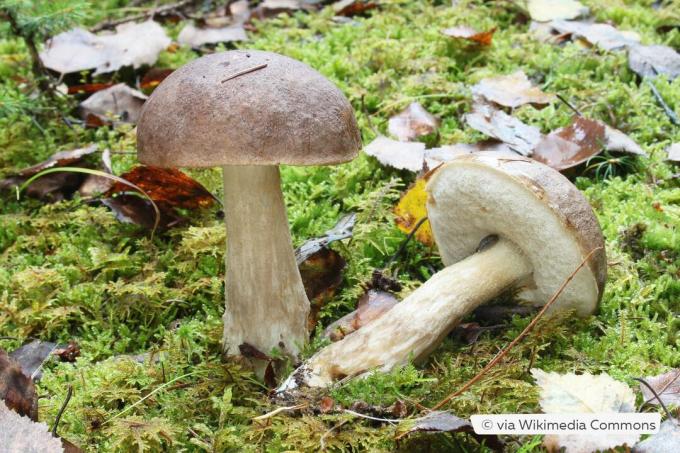
- Cap: grey-brown to red-brown, uneven, tomentose
- Stem: whitish to grey, woolly, tomentose
- Sponge color: whitish to grey
- Habitat: moist soil, peat soil
- Edibility: edible when young
- Risk of confusion: other boletus (all edible), birch mushroom species
Tinder fungus (Fomes fomentarius)
The tinder fungus was used in many ways in the past. Due to the decline in primeval forests with beech trees, the frequency of tinder fungi is also decreasing.
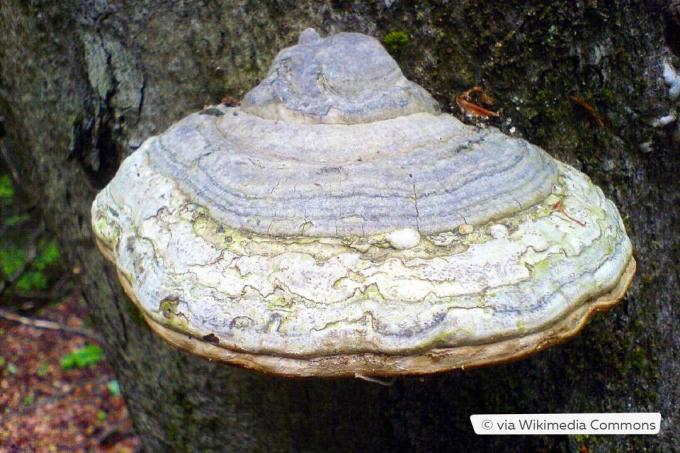
- Cap: hemispherical to plate-shaped, grey-brown to orange-brown
- Stem: no stalk, firmly attached to the tree
- Sponge color: whitish to rusty brown
- Location: mainly on beeches
- Edibility: inedible
- Risk of confusion: other fire sponge species, different Porling species
A notice: Tinder fungus is considered a medicinal mushroom in traditional Chinese medicine. It is dried in small quantities and added to various dishes or drunk as a tea.
frequently asked Questions
No, some species are edible and have high food value. Some species are only partially edible or must be specially prepared to be edible. It is usually sufficient if the mushrooms are heated for a long time. Some species are inedible very poisonus. Therefore, you should only eat mushrooms that you have been able to clearly identify.
Colloquially, some sponge mushrooms are also referred to as boletes, since the fruit layer is made up of many individual tubes. However, the term "boletus" is mainly used for mushrooms that grow on the ground. This term is not used for fungi that grow on trees.
Whether the sponge is eaten with edible mushrooms or not depends on personal taste and the way it is prepared. If the mushrooms are dried, the sponge often stays on. With fresh preparations or when the mushrooms are frozen, many people remove the sponge because the consistency is occasionally perceived as unpleasant.
